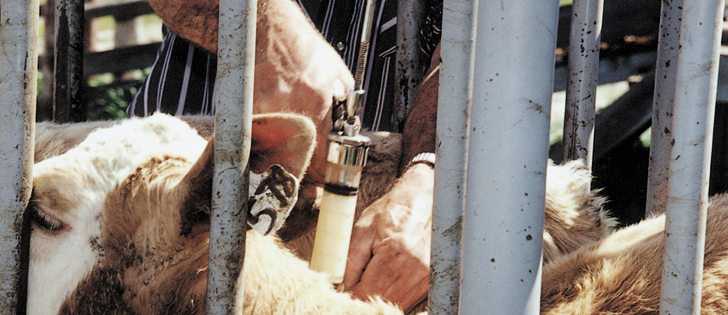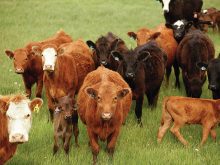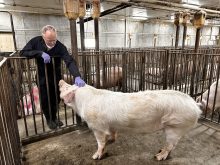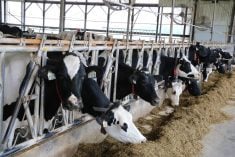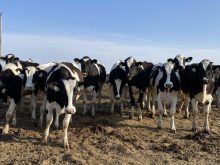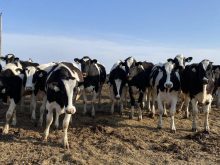Bovine respiratory disease is one of the most common and economically important diseases of the beef industry in North America.
The risk factors have been well-described and the most important risk factor continues to be weaning. Weaning causes significant stress to the calf and can have major impacts on the calf’s immune system. Reducing weaning stress by using techniques such as two-step weaning nose tags or separating the stress of weaning from introduction to the feedlot are important strategies for minimizing BRD. Other risk factors include lack of immunity (vaccines), abrupt diet changes, castration, parasites, mixing of cattle, dusty conditions and concurrent diseases.
Read Also

Beef check-off collection system aligns across the country
A single and aligned check-off collection system based on where producers live makes the system equal said Chad Ross, Saskatchewan Cattle Association chair.
Numerous research trials have shown that preconditioning and pre-vaccinating calves can have a significant impact on decreasing the number of animals that get sick from BRD when entering the feedlot and the number of animals that die from BRD. Preconditioning has been used for more than 50 years by some cow-calf producers. It involves weaning the calves at least 30 days (45 more commonly) before entry to the feedlot, ensuring that the calf is appropriately vaccinated against BRD, treated for internal/external parasites, and all surgeries such as dehorning or castration are performed well ahead of weaning or sale.
A study conducted at Oregon State University and published in the upcoming edition of the Journal of Animal Science examined the impact that the timing of vaccination for respiratory disease can make on the antibody response and performance of feedlot cattle. The study involved only 69 Angus-Hereford cross calves that weighed about 475 pounds at the beginning of the study. The researchers assigned the calves to one of three different treatments. The “control” calves were vaccinated at weaning and then given a booster vaccine at feedlot entry (30 days later). The “early” calves were vaccinated 15 days before weaning and then given a booster vaccination 30 days later, which corresponded to 15 days prior to feedlot entry. The final group was designated as the “delayed” group and were vaccinated 15 days after weaning and then given a booster vaccine 15 days after arriving in the feedlot. All of the calves had received clostridial vaccine and a killed viral vaccine at about 45 days of age. The vaccines given around weaning and feedlot entry consisted of a clostridial vaccine and a modified live viral vaccine that vaccinated animals against infectious bovine rhinotracheitis, bovine respiratory syncytial virus, bovine viral diarrhea virus Types 1 and 2 and mann-heimia haemolytica.
Calves were weaned off pasture and given a pour-on anthelmintic and then after seven days were allocated to dry lot pens. Thirty days after weaning, the calves were transported almost 1,500 kilo-metres to a feedlot to mimic conditions that many calves in North America would undergo upon entry to the feedlot.
The researchers took blood samples and measured antibody levels against mannheimia haemolytica and bovine viral diarrhea to assess which group had the highest immune response to the vaccines given. The early calves vaccinated pre-weaning and again prior to entry to the feedlot had the highest levels of antibodies when compared to the control and delayed groups.
The calves vaccinated in the early group also had increased average daily gain during the receiving period in the feedlot when compared to the other groups.
Although the early-vaccinated group also had lower numbers of animals getting sick and lower levels of mortality, the trial wasn’t large enough to show those differences as statistically significant.
This experiment provides a little more evidence to suggest that the pre-vaccination component of a preconditioning program helps prepare calves for the feedlot environment by boosting their immunity.
Those calves that were well vaccinated before shipping to the feedlot had higher antibody responses and better average daily gain during the receiving period.
Feedlot managers often have to assume the calves they receive have not been vaccinated when they arrive and vaccinate everything on arrival to the feedlot.
We know that respiratory disease cases often occur within the first week of arrival in the feedlot and some calves are incubating disease when they arrive. It only makes sense that our vaccines might be more effective if given before this period of risk rather than just after they arrive at the feedlot.
As we try to become better stewards of the antibiotics that we use to treat and prevent bovine respiratory disease, we will need to find a way to encourage the appropriate use of vaccines before feedlot entry so that we reduce the impact of respiratory disease and improve the welfare of calves.
John Campbell is head of Large Animal Clinical Sciences at the University of Saskatchewan’s Western College of Veterinary Medicine.



